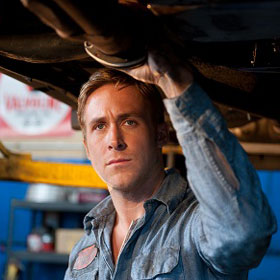Drive

4.5/5
In what could be construed as self-conscious self-loathing, there are many Hollywood movies that fall back on the myths and tropes of life in Tinseltown. A good number of these films deal with the industry -its ugly side, its politics, its absurdity -perhaps as an effort to throw light on the creative processes of the studios and their red tape, the hierarchies and the unseen pressures.
In a way, the public has been taught to see the movie industry as a vaguely criminal enterprise, going all the way back to the Golden Age when the studio system resembled something like racketeering. The town is filled with opportunists and exploiters, moguls and kingpins, strong-arm lawyers, all gangsters depending on the context. So it should come as no coincidence that a noticeably large number of ‘Hollywood’ movies are, on the surface, about the criminal underbelly of Los Angeles.
Drive is no different, and yet it is. Nicolas Winding Refn’s eye-popping and sensual thriller follows a Hollywood stunt car driver who becomes involved in a heist that goes predictably wrong. As per usual, the boss wants his money back and every last party dead, including Ryan Gosling’s driver. The movie prescribes to a thematic idea of Hollywood, but only as a colorful backdrop.
It’s evident this was a purposeful move on Refn’s part. Rather than a clueless play off established themes and norms, Drive flaunts its Hollywood roots without overindulging them, as if the setting and the events in the movie were business as usual. While the story is a pretty straightforward stoic-badass-takes-on-syndicate plot, the audience will have no problem looking past other tired attempts at the genre and finding believability. Precisely because it is what it is.
Refn has taken steps to create an isolated example of a genre and has the good sense to leave it at that. He doesn’t tip his hat too obviously, and he doesn’t try to transcend. Even the title of the film is honest and unassuming. But what really sets Drive apart from similar movies is style. Refn’s L.A. is reminiscent of the city in David Lynch’s Mulholland Drive. The long, silent drives down emptied streets, tastefully shot from the driver’s perspective, are emblematic of the city’s isolating culture. The aerials of equally desolate blocks dressed in the sulfur-orange of streetlights and the incredible panning night scenes of downtown L.A. are painfully vivid and get you close enough to the city without letting you in.
The sounds too, might remind one of Lynch. Drive is an unsuspectingly quiet movie. Most scenes lack a typically sufficient amount of dialogue; Gosling has, maybe, a few pages worth of lines. It all makes for an extremely atmospheric movie and a textbook application of sonic tension. Even the scenes when Gosling is driving solo, the engine sounds from the car are more like white noise than adrenaline fodder. And as with Lynch films, the Drive audience gets the feeling that real importance and story lies in the silent gaps between action. So when a gun finally fires, or a car revs up and squeals its tire, the aural shift is jarring and surprising, but completely realistic, the way a shotgun blast would make anybody jump up from their seats.
Above all, Refn’s movie is one for the senses. The environments that the characters inhabit are high-definition versions of real life. The characters themselves are rigid archetypes. Gosling’s driver, ostensibly named the Kid, is the perfection of one dimensionality. So much so, that when he looks into the camera after having booted in some assassin’s skull, the audience can do nothing but laugh. The Kid’s signature silver scorpion jacket gets progressively more bloodstained as the movie rolls along, creating a sort of running joke. Even when Christina Hendricks gets her head blown off, in slow motion, after only a few short scenes, the audience is near to applauding Refn’s brazen move.
This all goes to say that Drive is a moody and visually stunning thriller without all the baggage of genre. The movie is intelligent too, but not overbearing. Its moral standing is about as clear as that of Taxi Driver. The ambiguity of the film is its true value. There doesn’t seem to be any motivation behind Gosling’s character, why he chooses to protect his neighbor and her child, or why he doesn’t just take the money and run. And yet there’s no question about the movie’s own motives: if these events weren’t set into motion, if the heist didn’t go wrong or if the Kid didn’t fall in love, then there’d be no movie to watch. If the plot was too complicated and clogged by intellectual ambition or a morality, the film wouldn’t kick as much ass. It’s as simple as that.
Anyone familiar with Refn’s work will know he’s the type of director that makes “manly art-house flicks.” His other films, notably Bronson and Valhalla Rising, lack pretention or a clearly subjective touch, but still display an incredible amount of sophistication and know-how. Refn is out to make movies that look really, really cool, sound like strange, distorted dreams and have scenes of violence that would make Charlie Manson squirm. And Drive, as homage to Hollywood and the thriller genre, is about as slick and gory as they come. If you are enthusiastic about modern cinema but want to circumvent all the film-buff b.s., then Drive is right type of movie for you.
RELATED ARTICLES
Get the most-revealing celebrity conversations with the uInterview podcast!





Leave a comment